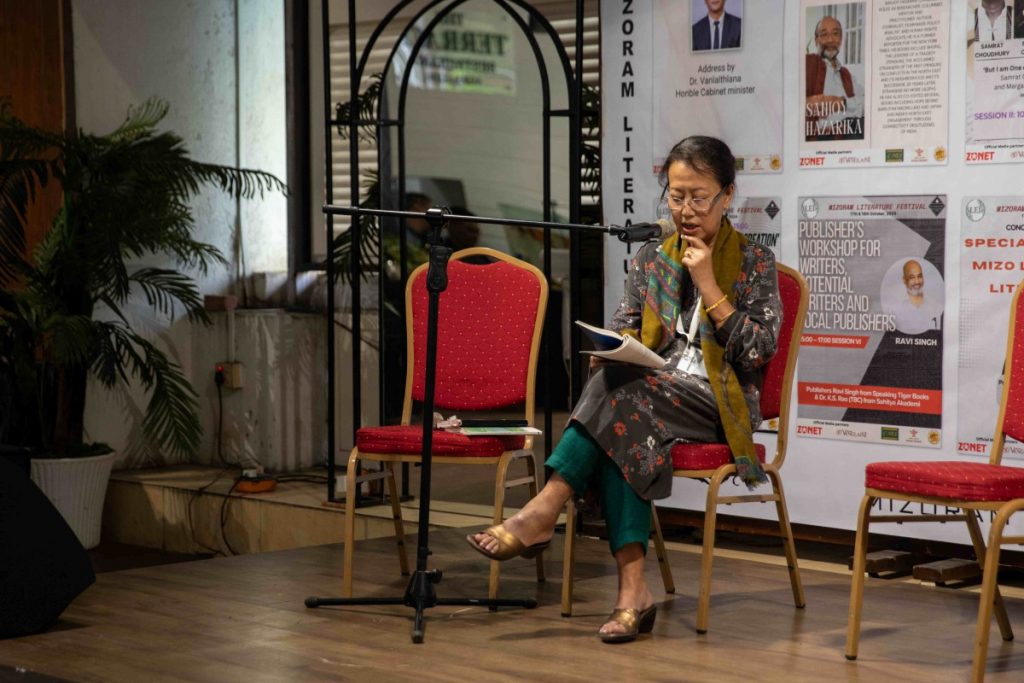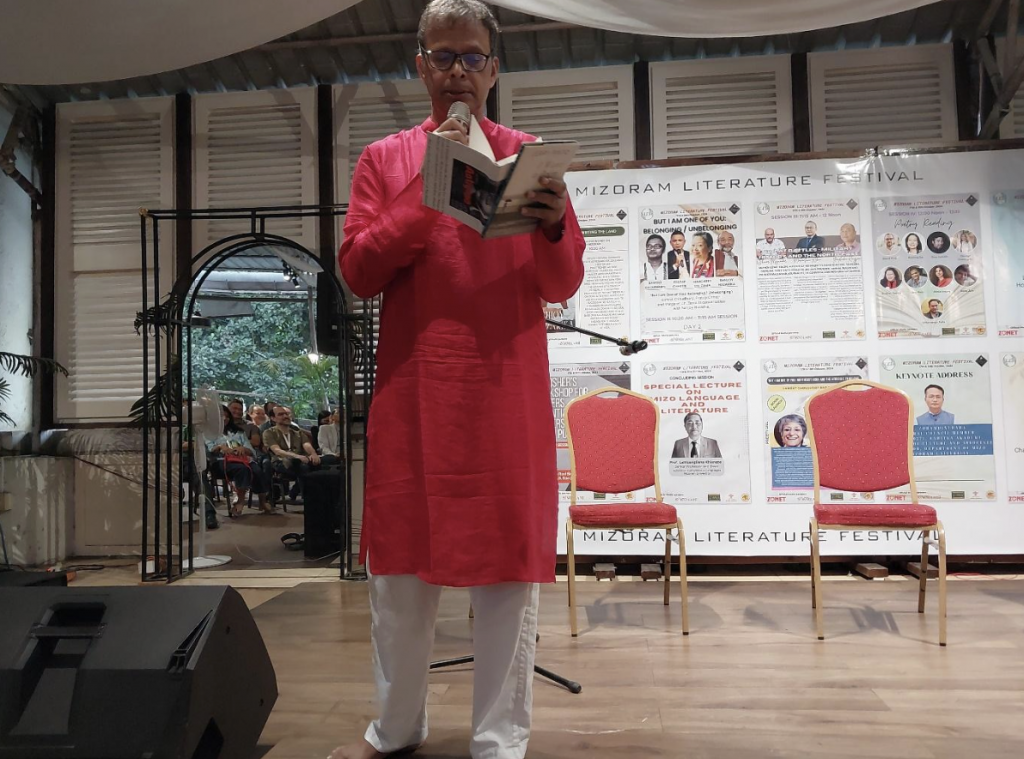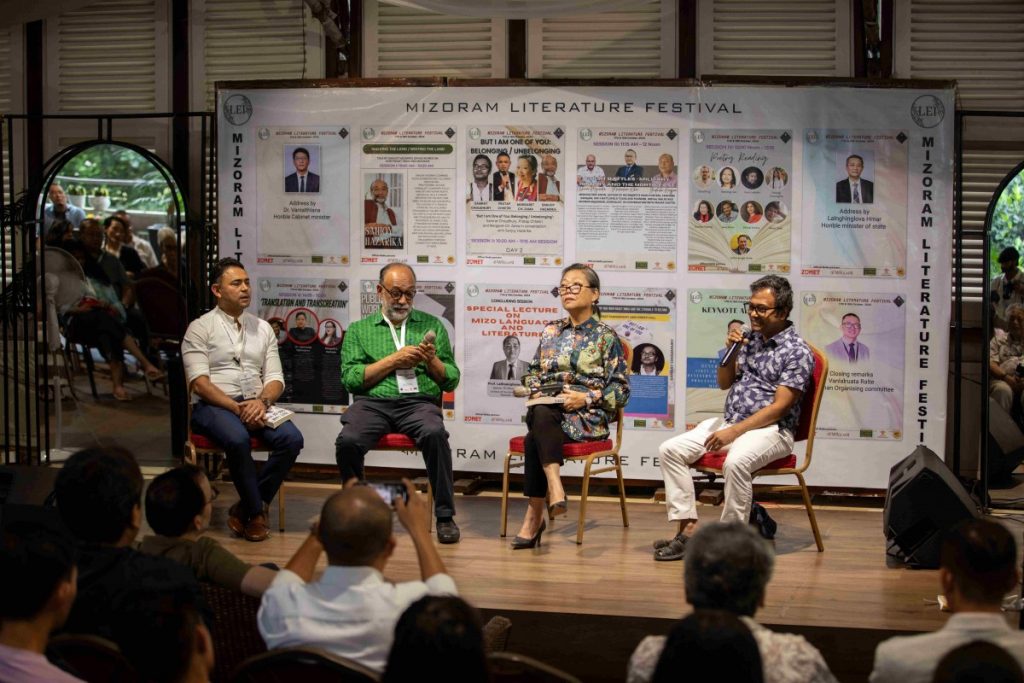Voices, Dialogue and Diversity: A Literature Festival in Mizoram
Organising a literature festival is a daunting task; organising the inaugural edition of one must be even more so. A small group of literature lovers organised the first Mizoram Literature Festival (MLF) in Aizawl on October 17-18, 2024. Events at every scope, large and small, offer unique attractions. As a non-participating attendee at MLF, I enjoyed the best of both worlds: meeting some prominent figures of Indian literature as well as enjoying an intimate atmosphere where the focus was less on networking and more on the actual sessions.
I attended MLF at the invitation of fellow writer Lalremruati “Tetei” Chhangte, founder and editor-in-chief of Indian literary magazine Mean Pepper Vine. Tetei was one of MLF’s organisers. Other organisers included the proprietor of Aizawl's The Book Café, Vanlalruata Ralte, deputy director of the Department of Information and Public Relations Pratap Chhetri, poet Mona Zote, and Government J. Thankima College assistant professor Lalthansangi Ralte. Several state officials addressed the audience through the festival, as did Zoramdinthara, Mizoram’s representative in the Sahitya Akademi’s General Council.

Art exhibition on the lawn terrace by students from Mizoram Academy of Arts and Boomat India. Photo: DIPR, Government of Mizoram
MLF was organised at the Aijal Club, a late-19th century British institution. The festival featured art exhibitions and stalls by Mizoram Academy of Arts and Boomat India, and a book exhibition by The Book Café. Students from Mizoram University, IIMC Mizoram, ICFAI University, and other educational institutes formed a lively and engaged audience. Special invitees included David Puig, the Dominican Republic’s Ambassador to India. Puig is also the founder of a small press, Ediciones de a Poco, and a poet. In his keynote address, he compared the blue archipelago of the Caribbean, his home region, with the green archipelago of Northeast India. Colonial rule is one feature these two regions have in common; another is the fact that connectivity (by air, for instance) is often better between each Caribbean island (or northeastern state) and the mainland than between islands (or between states): a form of internal fragmentation with wide-ranging repercussions.
MLF foregrounded literature from Mizoram and the rest of the northeast, both in English and in regional languages. Multilingualism was a recurring feature, with several writers reading works in two languages. Regarding whether Mizos should make concerted attempts to write in English, opinions were divided. Several attendees suggested that young Mizo writers should read and write more widely in English to broaden their audience. (To contextualise this recommendation, Mizoram has a literacy rate of 91.3%, one of the highest in India.) Margaret Ch. Zama, in contrast, discussed the extensive extent to which spoken Mizo (like Mandarin Chinese) relies on variations in tone, which often give a word one of a whole number of unrelated meanings; given that these variations are for the most part unrepresented in the graphology, Mizo as a language, Zama argued, is peculiarly liable to losing richness and specificity when translated, as well as when Mizos write about Mizo experiences in English. (Mizo lacks a script of its own; Mizo is written in the Roman script and has 25 letters. But unlike Turkish, for instance, which is also written in the Roman script, the Mizo English script lacks accent marks to indicate semantically relevant variations in tone.)
Illustrating this key role that tone plays in meaning in Mizo, this first edition of MLF was called Lei, a word that, depending on tonal variations, can mean bridge, or tilt, or tongue.
The role of fable in northeastern literary traditions was often discussed. Celebrated writer Mamang Dai suggested the continuing influence of ancient oral traditions, specifically that of the long narrative poems encompassing a person’s whole life. The influence of these traditions, perched between reality and fantasy and constituting a species of magical realism, is a distinct feature of contemporary northeast Indian literature. Dai also pointed out the potential for language to be politically weaponised – a tragic aspect of the region’s history – and the need for greater collaboration between writers from India in general and the other Commonwealth nations.

Mamang Dai during the session ‘North by Northeast.’ Photo: DIPR, Government of Mizoram
Translation was another key issue. Jerry Pinto regaled the audience with a story of his first major translation job as a young man. Rendering Sachin Kundalkar’s Cobalt Blue from Marathi into English, Pinto rewrote the ending to suit his own tastes. Having reviewed the translation, Kundalkar uttered to Pinto the dreaded words, “We have to talk.” Pinto recounted shaking in his sandals as he faced the literary giant. Kundalkar, however, merely pointed out the young translator’s error and requested a rewrite. “Looking back, I marvel at my egotism,” Pinto concluded. He reminded the audience, “When people read a translated book, they’re not coming for you, the translator. They’re coming for the original author." Margaret L. Pachuau, another prominent writer-translator, agreed, suggesting that one of the rewards of translation – an often unenviable and unremunerative endeavour – is that the sensitive writer/translator has the opportunity to acquire a second, distinctive voice, i.e. that of the original author.
Poetry, often relegated to the back of bookstores and literature festivals, took centrestage at MLF. Lalnunsanga Ralte laughingly lamented a recent transition: a veteran participant of Young Writers panels, he now found himself over the hill and hosting, rather than featuring in, this festival’s Young Writers panel. This session featured rising Mizo poets offering readings in one or both languages. Tatea Royte offered a poem positioning coffee-drinking within our increasingly instrumentalist, productivity-oriented culture, and expressed the poet’s own distaste for this darling beverage of the Silicon Valleys of both hemispheres. Lalremruata Sailo read “The Little Bread Thief,” an ode on the human power of forming friendships across boundaries of age, culture, and gender, and to the multicultural essence of Mizo identity.
Dr. Ralte himself offered a delightful satire on gendered ethics. In his interpretation of the Indian moral code, a Mizo man must not indulge in alcohol, nicotine, or revolutionary politics; whereas for a Mizo woman, the key is not what she does, or where, or with whom – all will be well as long as she gets home on time. This clever poem, with its echoes of the thoughtful Bollywood film Pink, had the audience roaring with rueful laughter.

Jerry Pinto reads his poetry. Photo: DIPR, Government of Mizoram
Shinie Antony offered a complementary but distinct perspective on gendered experiences. She asked us to picture a young woman in India entering a lift. Our fictitious heroine keeps her eyes demurely lowered lest she encounter a dozen pairs of ogling male eyes. Once a woman reaches a certain age, however, she becomes practically invisible, with strangers on the street speaking through her and walking into her. This, Ms. Antony suggested, is one of several mechanisms by which women become freed to finally voice their rage – a human rage, multifarious in origin and often justified; the kind of rage that men indulge in throughout their lives. This idea of rage making a man more masculine, and a woman less feminine, also finds vivid articulation in Ms. Antony’s many popular novels.
Pinto offered a reading of his powerful poem “I pray because I do not know what else to do,” which begins:
“Don’t speak until you understand the issue
I’ve heard this said often because
I am often the person saying it…”
This poem offers several interventions: (a) It is possible for a rational person to empathise with both sides of a conflict like the ongoing Israel-Hamas war; (b) We live in a culture that seems to mandate constant vocalisation. Given the mindboggling complexity and numerosity of contemporary issues, it’s impossible to quickly formulate a coherent opinion. (c) The fact that everybody else is opinionating relentlessly doesn’t excuse this activity. That is, might still does not make right. Pinto’s tongue-in-cheek humour, which points the finger always and first at himself, allows a difficult message like this to penetrate audience emotions. Pinto’s stage presence is warm and open (he ridiculed, for instance, the idea that any writer can fearlessly ‘be himself’ in public) but also fiery and, in a small crowd, potentially overwhelming. Well-known to frequenters of India’s established literary festivals, this presence was a galvanising force at MLF, as Pinto generously shared himself with old friends and new acquaintances.
Pinto’s top moment occurred on Day Two. The programme, thanks to the up-to-the-last-minute vagaries of the schedules of invited dignitaries, was running late. The pre-lunch poetry session began over an hour late. As if on cue, the numerous students in the audience formed a winding beeline for the chicken samosas and masala tea, disrupting the first few readings. Pinto, reading at the close of this session, offered a poem which he insisted “excluded present company” but which, to the organisers’ delight, had in fact clearly been composed impromptu to criticise the allegedly low priority that literature festivals give to poetry readings. This performance was offered, and received, goodhumouredly.
Mizo history featured heavily at MLF. The inaugural lecture was delivered by Joy L. K. Pachuau of JNU. Pachuau’s books include Being Mizo (2014) and The Camera As Witness (2015), a book-length coauthored photo essay on Mizo history from precolonial to contemporary times. A historian and anthropologist, Pachuau uses a multiplicity of perspectives, including naïve insider and outsider views as well as academic approaches, to examine the forces shaping contemporary Mizo identities.
Personal and professional perspectives on Mizo history were the focus of several sessions. MLF featured the launch of a book: But I Am One of You: Northeast India and the Struggle to Belong (HarperCollins, ed. Samrat Choudhury and Preeti Gill). Margaret Ch. Zama read from her essay in this book: a powerful piece of narrative nonfiction recounting her experience coming home from boarding school during Mizoram’s 1966 Rambuai uprising. Then a teenager, Prof. Zama found her village, her family businesses, and her family home all razed and soot-blackened from the Indian Army’s aerial bombing counterstrikes. In the middle of a moving and articulate reading, Zama was compelled to pause when reading out a passage about safely reuniting with her family. It was a moment where my eyes, chronically dry, teared up. I’m sure I wasn’t alone in this experience. The Assam Rifles were involved in the 1966 Indian Army counterstrike. In an interesting turn of events, three members of the Assam Rifles occupied front-row seats as invitees at MLF.
The programme also featured a session dedicated to military history & the North-East, featuring contributions by Mmhonlumo Kikon, Yaiphaba Kangjam, and Ushinor Majumdar. This session addressed, among other topics, the involvement of northeast India and Burma in the World War II.

Left to right: Pratap Chhetri Sanjoy Hazarika, Margaret Ch. Zama, and Samrat Choudhury at the launch of But I Am One of You. Photo: DIPR, Government of Mizoram
Sanjoy Hazarika discussed the origins of his own interest in documenting northeast history. One anecdote the young Hazarika collected involved a Brigadier friend in the Indian Army whose son had joined the Mizo revolutionaries. “I give him one or two years,” was the Brigadier’s expectation regarding his son’s lifespan going forward. The dreaded phone call, however, came sooner than expected. The bereft father, presented with two bodies, realised neither belonged to his son. A fellow soldier, however, advised the Brigadier in a whisper to play along. The two dead strangers were dutifully interred. Unbeknownst to the stiff-necked Brigadier, his son, alive and well, was watching the proceedings from behind a hedge ten yards away.
MLF invitees stretched their legs between sessions, striking up conversations with strangers – something unlikely to occur at larger literary festivals, where top authors are escorted from venue to venue by armies of officious student volunteers, who protect a literary star from hoi polloi as from an army of exploding hedgehogs. Out on Aijal Club’s lawn terrace, amidst clotheslines bristling with pen-and-ink and watercolour productions by student artists, sat a gifted young artist painting portraits on demand for Rs 50 apiece. Over two days of haunting this stall, vainly awaiting my turn, I came to admire not just this student’s artistic skill, but also his powers of discrimination. Scarcely speaking a word, he nonetheless discerned which client would appreciate a caricature and which dressed-to-the-nines self-designated Instagram influencer would expect to be prettified on paper.
Discussions around publishing closed MLF. Ravi Singh, founder of Aleph Books, and founder and current head of Speaking Tiger, discussed his three decades of experience in Indian publishing. (Speaking Tiger publishes MLF invitees Pinto, Antony, and Dhruba Hazarika, as well as numerous other Indian writers.) Writer Anita V.L. Nunmawii discussed the prospects and challenges of setting up as an independent publisher in India today. Singh offered honest perspectives and helpful tips to aspiring writers and publishers. “You’ve got to be in it for the long run,” he concluded, “if you want to make a difference.” Puig suggested starting small, perhaps publishing just one book a year for the first several years.
MLF closed with Zoramdinthara felicitating Mizo awardees of the Padma Shree.

The invitees and organisers at the close of the festival. Photo: DIPR, Government of Mizoram
Sahitya Akademi was one of the sponsors of MLF. As several speakers noted, the Akademi’s recent recognition of Mizo as a classical language of India formed a landmark in the celebration of Mizo language, literature, and culture.
Given the organisers’ largely non-literary day jobs and demanding schedules, the Mizoram Literature Festival must have presented considerable organisational challenges. Given its success, however, I’m confident this will be the first of many editions, and that MLF will become a key platform for dialogue and collaboration, whereby the literature of northeastern India will achieve greater and much-deserved prominence in the wider world.
Amita Basu is a Pushcart-nominated writer whose fiction appears in over 70 venues including The Penn Review, Bamboo Ridge, Jelly Bucket, Phoebe, The Bombay Literary Magazine, and Funicular.
This article went live on October twenty-seventh, two thousand twenty four, at nineteen minutes past nine in the morning.The Wire is now on WhatsApp. Follow our channel for sharp analysis and opinions on the latest developments.




